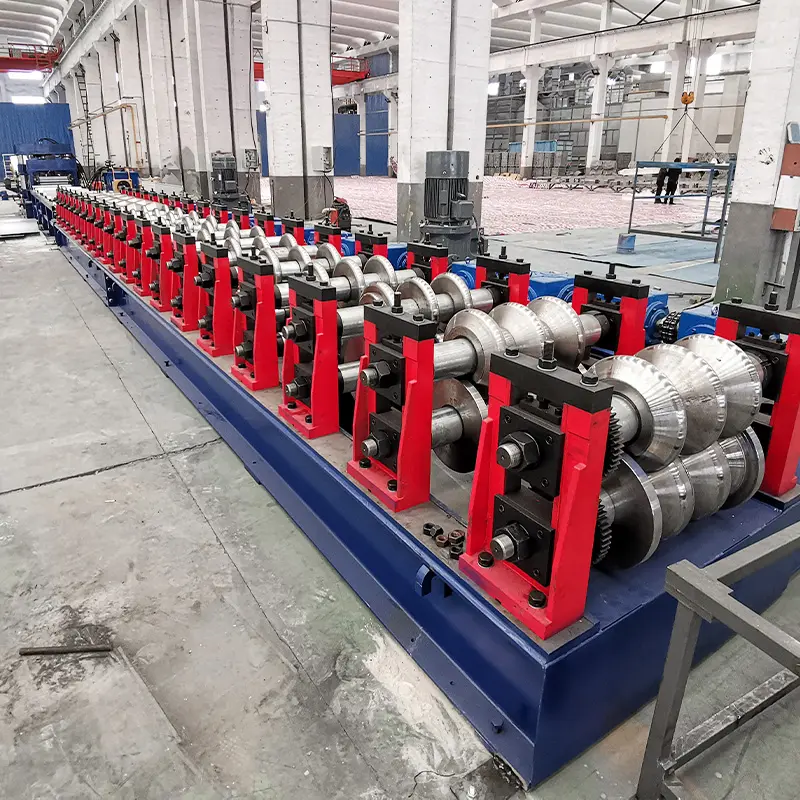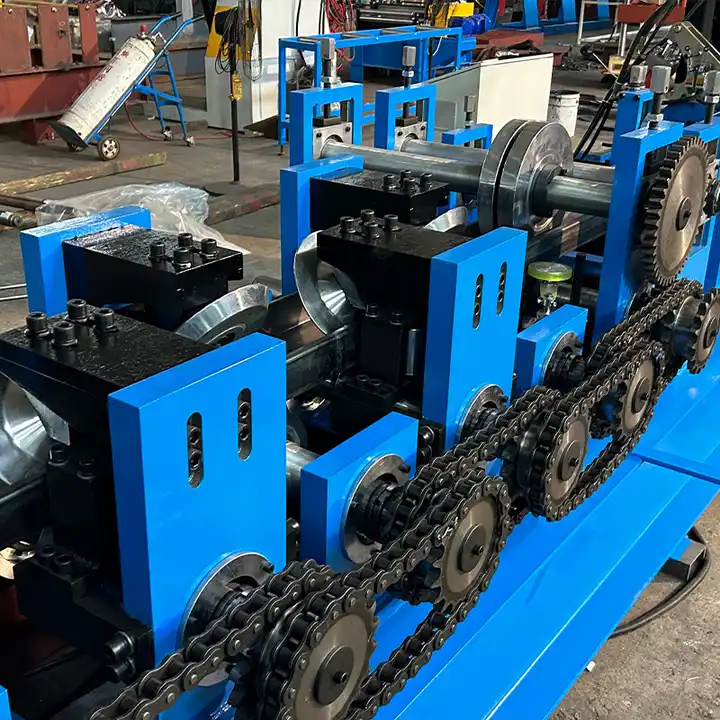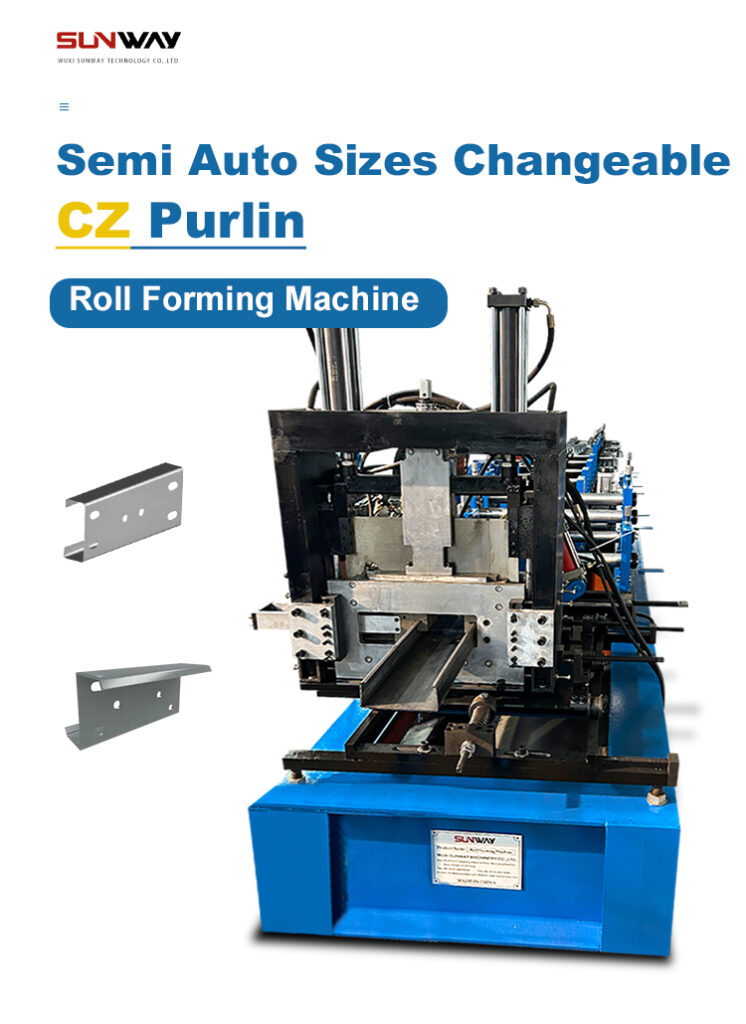Flying-shear roll forming machines utilize a unique cut-to-length system to boost efficiency in roll formed profile production. The flying shear mechanism shears the moving strip just before it enters the roll forming section.
Key details about flying-shear roll formers:
- Cut-to-length system integrated into roll former
- Rotary shear cuts moving strip at high speed
- Precise shear timing synchronized to line speed
- Permits faster overall line speeds
- Quick and easy size changes
- Used for metals up to 4mm thickness
- Ideal for producing parts in standard lengths
- Commonly used to make roofing panels, decking, and panels
By removing the stop-and-start action of typical end shears, flying shears optimize the roll forming process.
Types of flying-shear roll forming machine
| Machine Type | Description |
|---|---|
| Mechanical | Shear timing via Geneva mechanism and servo drive |
| Electronic | Shear controlled by PLC with encoder feedback |
| হাইড্রোলিক | Hydraulic cylinder actuates shear at right moment |
Mechanical flying shears precisely time the cut mechanically for a simpler, economical design.
Electronic flying shears offer more flexibility and speed control through the system’s logic controller.
Hydraulic flying shears generate high shearing force while maintaining accurate timing.

Key Components of Flying Shear Roll Formers
| Component | Function |
|---|---|
| ডিকয়লার | Feeds strip from coil into line under proper tension |
| Roll Tooling | Forming stations gradually shape the strip |
| Flying Shear | Rotary shear cuts moving strip at high speed |
| Conveyor | Receives cut parts and discharges from line |
| PLC Control | Coordinates decoiler, shear, conveyor, and monitoring |
| Operator Interface | Touchscreen to control and adjust forming parameters |
Flying shears combine dynamic roll forming technology with synchronized high speed shearing for superior productivity.
Typical Applications of Flying Shear Roll Forming Lines
| পণ্য | বিস্তারিত |
|---|---|
| Roofing Panels | For standing seam, concealed fastener panels |
| Siding and Cladding | Wall panels, architectural facades |
| Decking | Roof deck, flooring panels |
| Solar Frames | For solar panel mounting structures |
| Shelving | Adjustable shelves, support beams |
| Drainage Systems | Culverts, rain gutters, downspouts |
Flying shear roll formers are ideal for producing roofing, siding, decking, and numerous profiles in standard lengths.
Design Standards for Flying Shear Roll Forming Machines
| Component | Standards |
|---|---|
| ফ্রেম | Rigid steel, stress-relieved welded construction |
| Tooling | Hardened rolls, machined shafts, bearings |
| Shear Blade | Hardened D2 steel, heat treated |
| Shear Timing | Precise Geneva or electronic control |
| Drives | Helical gearboxes or servo motors |
| Controls | PLC, color touchscreen HMI |
| Finishes | Primed then powder coated |
| Safety | Fully enclosed guards, e-stops |
Robust framing matched with high quality components and smart controls result in reliable, consistent performance and end product quality.
Specifications of Flying Shear Roll Formers
| Specification | Typical Values |
|---|---|
| Line Speed | 10 – 50 m/min |
| Max Strip Width | 1000 – 1300 mm |
| Thickness Capacity | 0.5 – 4 mm |
| Length Tolerance | ± 1 mm |
| Length Range | Any cut length |
| শক্তি | 30 – 75 kW |
| Machine Weight | 5000 – 8000 kg |
Speeds, widths, and power requirements vary across mechanical, hydraulic, and electronic flying shear machine models.
Pricing Details for Flying Shear Roll Forming Equipment
| Manufacturer | Price Range |
|---|---|
| Metform | $150,000 – $250,000 |
| ETP | $140,000 – $220,000 |
| Samco | $160,000 – $280,000 |
| China manufacturers | $80,000 – $150,000 |
Prices range from $80,000 to $280,000 depending on size, features, and precision. Installation and shipping add 10-20%.
Installation and Commissioning of Flying Shear Machines
| Task | Description |
|---|---|
| Site Preparation | Clear space, anchor bolts to foundation |
| Lifting | Use appropriate lifting gear to offload sections |
| Assembly | Bolt frame together; install components |
| Alignment | Precision align and level all sections |
| Electrical | Wire motors, PLC, controls, and accessories |
| Conveyor | Bolt in feed and exit conveyors |
| Test Run | Cycle slowly, inspect operation and cut parts |
| Optimization | Refine shear timing, control parameters |
Proper installation and thorough testing ensures smooth startup and quality output from the machine.

Operation and Maintenance of Flying Shear Roll Lines
| Activity | Frequency |
|---|---|
| Safety Checks | Per shift |
| Coil Loading | As needed |
| Parameter Adjustment | As needed |
| Blade Lubrication | Daily |
| Blade Inspection | Weekly |
| Bearing Lubrication | Monthly |
| Hydraulic Service | Quarterly |
| Gearbox Oil | Per manual |
| Alignment | Annual |
Daily safety procedures must be followed. Careful operation and regular maintenance are vital for flying shear longevity and performance.
Selecting a Flying Shear Roll Former Manufacturer
| Considerations | Guidance |
|---|---|
| অভিজ্ঞতা | Look for extensive background with flying shears |
| কাস্টমাইজেশন | Ability to tailor machine to application needs |
| সমর্থন | Installation help, training, manuals, service |
| Reputation | Choose established brand known for quality |
| Delivery | Manufacturer can deliver on required schedule |
| Value | Balance capabilities against price paid |
Consider expertise with this specialized equipment along with customization, support, and fair cost.
Benefits of Flying Shear Roll Forming Lines
- Faster production than standard roll former with end shear
- Precisely cut parts immediately off the roll former
- Quick and easy size changeovers
- Increased throughput from uninterrupted strip flow
- Ideal for producing profiles in standard lengths
- Consistent cut tolerance and quality
- Compact design minimizes space
- Lower labor requirements
- Ability to cut to length on the fly
- Simpler material handling
Key advantages include speed, changeover ease, consistency, and labor savings versus typical stop-and-cut systems.
Limitations of Flying Shear Roll Forming Technology
- Higher initial capital cost than standard roll formers
- Requires more maintenance and skilled operation
- Limited to thinner/softer material gauges
- Not as easy to cut non-standard length parts
- Precise alignment critical for smooth operation
- Timing mechanisms can wear over time
- Special tooling required for different profiles
- Can increase roll changing time during size changes
- Scrap generation during initial setup
The main limitations relate to higher cost and maintenance requirements versus basic roll formers.
Cost Comparison of Flying Shear vs End Shear Machines
| Machine Type | Price Range | Benefits | Drawbacks |
|---|---|---|---|
| Flying Shear | $150,000 – $300,000 | Faster speeds, easy length changes | Higher cost, specialized maintenance |
| End Shear | $100,000 – $200,000 | Lower initial cost, simple operation | Slow cut-to-length method |
Flying shears improve productivity but have higher capital and operating costs. Evaluate based on volume, changeovers, and budget.
Troubleshooting Issues with Flying Shear Roll Lines
| Issue | Solution |
|---|---|
| Inaccurate shear timing | Adjust/replace worn gears; check encoder |
| Blade wear | Rotate/replace shear blades |
| Strip marks | Increase blade/roll hardness; adjust guides |
| Hydraulic leaks | Replace seals, hoses, cylinders |
| Excess vibration | Check alignment, mountings; repair as needed |
| Electrical faults | Check/replace wires, connections, drives |
Proper blade maintenance along with swift repairs of leaks, looseness, or electrical problems prevents unplanned downtime.

FAQ
Q: What thickness of steel can flying shears accommodate?
A: Most machines can handle up to 4 mm thickness. Heavier models are available for thicker material.
Q: How fast can flying shear roll formers operate?
A: Speeds range from 10 to over 50 meters per minute depending on machine size.
Q: What length parts can be produced?
A: Any cut length can be produced, though typical lengths are from 1 to 7 meters.
Q: How accurate are the cut lengths?
A: Precision flying shears can achieve a tolerance of ± 1 mm or better.
Q: How long does it take to change to a new profile?
A: With quick change tooling, profile changeover takes 30-60 minutes in general.
Q: What safety features are included?
A: Full guarding, e-stops, access interlocks, and control reliability per prevailing standards.
Q: What is the typical production lifetime of a machine?
A: Approximately 15-20 years of productive life can be expected with proper maintenance.
Q: What types of warranty are offered by manufacturers?
A: Warranty periods range from 6 months to 1 year on most components. Extended warranties may be purchased.
Frequently Asked Questions (FAQ)
1) How do flying-shear roll forming machines maintain ±1 mm cut accuracy at high speeds?
- By synchronizing the rotary shear’s servo or hydraulic motion to line speed using encoder feedback and predictive motion profiles. Anti-backlash gearboxes and rigid blade carriers minimize deflection during the cut.
2) What profiles are best suited to flying-shear systems versus stop-cut systems?
- Standard-length, continuous profiles like roofing panels, decking, purlins, studs, and channels benefit most. Highly variable, short parts with frequent non-repeating lengths are often more economical on stop-and-cut lines.
3) When should I choose mechanical vs electronic vs hydraulic flying shears?
- Mechanical: cost-effective, simpler for fixed speeds and limited recipes. Electronic (servo): highest flexibility, faster recipe changes, superior at variable speeds. Hydraulic: preferred for thicker gauges/high shear force with accurate timing via proportional valves and PLC.
4) What are typical blade materials and service life expectations?
- D2/HCHCR tool steel with 58–60 HRC for coated steel/aluminum; PM grades (e.g., CPM 10V) for abrasive materials. With proper lubrication and alignment, edge regrind intervals often range 80,000–150,000 cuts; full life 5–10 regrinds depending on material and thickness.
5) Which data points should be logged for predictive maintenance on a flying-shear line?
- Motor/valve command vs actual position, cycle time dispersion, shear torque/pressure peaks, vibration (RMS), blade temperature, cut-length error distribution, hydraulic oil temperature/contamination, and encoder health. Thresholds trigger inspections before drift impacts scrap rates.
2025 Industry Trends
- Servo-first architectures: Wider adoption of high-torque servo actuators replacing purely mechanical timing for dynamic speed changes.
- Closed-loop quality: In-line laser length verification and edge-tracking with automatic trim compensation reduce rework.
- Predictive maintenance: Vibration, torque, and thermal sensing plus ML models cut unscheduled stops by 20–35%.
- Quick-change ecosystems: Cartridge tooling and zero-point mounts push changeovers below 20 minutes.
- Safety and standards: Greater alignment to ISO 16092 (machine safety) and IEC 61508/ISO 13849 performance levels for control reliability.
- Energy optimization: Regenerative drives and smart standby reduce kWh/ton.
Key 2023–2025 benchmarks for flying-shear roll forming machines
| Metric | 2023 | 2024 | 2025 (est.) | Notes/Sources |
|---|---|---|---|---|
| Max practical line speed for roofing panels (m/min) | 60 | 70 | 80 | OEM catalogs; field reports |
| Typical cut-length CpK at 30–50 m/min | 1.33 | 1.45 | 1.60 | In-line metrology adoption |
| Predictive maintenance adoption on new lines (%) | 22% | 31% | 43% | Vendor and integrator surveys |
| Avg. changeover time with cartridge tooling (min) | 35 | 28 | 18 | Quick-change fixtures |
| Energy use, kWh per ton formed | 95 | 90 | 84 | Regenerative drives/optimization |
| Lines with functional safety PL d/e (%) | 48% | 56% | 65% | ISO 13849 implementations |
Authoritative references:
- ISO 13849-1 (Safety of machinery: safety-related parts of control systems): https://www.iso.org
- IEC 61508 (Functional safety): https://webstore.iec.ch
- AIST Sheet Processing and Roll Forming technical papers: https://www.aist.org
- PMA (Precision Metalforming Association) resources: https://www.pma.org
Latest Research Cases
Case Study 1: Servo Flying Shear With In-line Laser Verification Cuts Scrap (2025)
- Background: A decking manufacturer suffered variable cut-length drift during speed ramp-up, causing 1.8% scrap.
- Solution: Retrofitted servo flying shear with model-based motion profiles; added dual-head laser length measurement feeding a PLC correction loop; upgraded to zero-backlash couplings.
- Results: Scrap reduced to 0.6% (67% improvement); CpK for length rose from 1.25 to 1.62 at 55 m/min; unplanned shear maintenance events dropped 30% over 9 months. Sources: OEM retrofit report; plant QA data.
Case Study 2: Hydraulic High-Force Flying Shear for 3.5–4.0 mm Solar Rail (2024)
- Background: Solar mounting supplier needed accurate cuts on thicker galvanized rails without slowing throughput.
- Solution: High-response servo-hydraulic shear with accumulators and proportional valves; blade upgrade to PM tool steel; implemented oil cleanliness ISO 4406 targets with offline filtration.
- Results: Maintained ±0.9 mm at 32 m/min on 4.0 mm material; blade regrind interval extended 40%; hydraulic downtime reduced 25% via contamination control. Sources: Commissioning report; CMMS maintenance logs.
Expert Opinions
- Elena Petrov, PhD, Motion Control Lead, Bosch Rexroth
- “The biggest gains come from synchronizing motion profiles to coil speed ramps. Proper jerk-limited profiles reduce blade impact load and extend tooling life.”
- Mark Liu, Director of Manufacturing Engineering, Samco Machinery
- “Quick-change and alignment repeatability are the real OEE multipliers. If you control datum stack-up with cartridge tooling, you win back hours every week.”
- Prof. David Romero, Smart Manufacturing Chair, Tecnológico de Monterrey
- “Combining edge AI with vibration and torque signatures enables actionable maintenance within one quarter, typically paying back sensor retrofits in under 12 months.”
Practical Tools/Resources
- Standards and safety
- ISO 13849/ISO 12100 (risk assessment and control systems): https://www.iso.org
- OSHA Machine Guarding (U.S.): https://www.osha.gov/machine-guarding
- Design and process
- Roll Forming Handbook (Wiley): https://www.wiley.com
- PMA Roll Forming Council resources: https://www.pma.org
- Metrology and control
- CR On-Line laser length gauges (example vendor): https://www.chromaprecision.com
- NI CompactRIO/OPC UA integration for PLC analytics: https://www.ni.com
- Maintenance and analytics
- Vibration monitoring primers (Mobius Institute): https://www.mobiusinstitute.com
- ISO 4406 oil cleanliness coding: https://www.iso.org
- Vendor ecosystems
- SICK/Keyence sensors for encoder and edge tracking: https://www.sick.com | https://www.keyence.com
Implementation tips for Flying-Shear Roll Forming Machines:
- Use jerk-limited servo profiles and pre-emptive synchronization during acceleration/deceleration phases.
- Specify blade materials matched to substrate and coating; maintain blade parallelism within 0.02–0.05 mm.
- Log cut-length error histograms by speed segment; apply closed-loop corrections in PLC.
- Target oil cleanliness to OEM spec (e.g., 17/15/12 per ISO 4406 for servo hydraulics); add offline filtration.
- Adopt zero-point tooling and encoded setups to shrink changeovers below 20 minutes.
Sourcing checklist:
- Require encoder resolution/spec, controller scan time, and demonstrated CpK at target speeds.
- Verify functional safety architecture (PL d/e), guarding, and e-stop categories with third-party documentation.
- Request OEE, energy (kWh/ton), and maintenance KPIs from reference installations.
- Confirm spare blade supply, regrind program, and lead times for critical components.
Last updated: 2025-10-28
Changelog: Added 5 FAQs; included 2025 market and performance trends with data table; provided two 2024/2025 case studies; added expert opinions; compiled practical tools/resources; added implementation and sourcing checklists tailored to flying-shear roll forming machines
Next review date & triggers: 2026-05-31 or earlier if ISO/IEC safety standards update, major servo/hydraulic component revisions, or new OEM benchmarks for speed/accuracy are released
